Vedantu’s Solutions for Chapter 6 - Tissues, Science of Class 9 Science
Free PDF download of NCERT Exemplar for Class 9 Science Chapter 6 - Tissues solved by expert Science teachers on Vedantu as per NCERT (CBSE) Book guidelines. All Chapter 6 - Tissues exercise questions with solutions to help you to revise the complete syllabus and score more marks in your examinations. The NCERT Solutions are always beneficial in your exam preparation and revision. Download NCERT Solutions for Class 9 Maths from Vedantu, which are curated by master teachers. Science Students who are looking for Class 9 Science NCERT Solutions will also find the Solutions curated by our master teachers helpful.
Access NCERT Exemplar Solutions for Class 9 Science(Biology) Chapter 6 - Tissue
Exercise
Multiple Choice Questions
1. Which of the following tissues has dead cells?
(a) Parenchyma
(b) Sclerenchyma
(c) Collenchyma
(d) Epithelial tissue
Ans: (b) Sclerenchyma
Sclerenchyma is the only tissue made up of dead cells. All the other options mentioned are composed of living cells.
2. Find out the incorrect sentence
(a) Parenchymatous tissues have intercellular spaces
(b) Collenchymatous tissues are irregularly thickened at corners
(c) Apical and intercalary meristems are permanent tissues
(d) Meristematic tissues, in their early stage, lack vacuoles
Ans: (c) Apical and intercalary meristems are permanent tissues
Meristematic tissues are not considered permanent tissues because they divide and re-divide speedily.
3. Girth of stem increases due to
(a) apical meristem
(b) lateral meristem
(c) intercalary meristem
(d) vertical meristem
Ans: (b) lateral meristem
Lateral meristem is responsible for secondary growth. Cell division in meristematic tissues widens the diameter and ultimately increases girth. Whereas, the apical meristem is responsible for extension in root and shoot and intercalary meristem boosts the growth of plant parts.
4. Which cell does not have a perforated cell wall?
(a) Tracheids
(b) Companion cells
(c) Sieve tubes
(d) Vessels
Ans: (b) Companion cells
The cell wall which has pores and holes in it is called a perforated cell wall. It is obligatory to have a passage for water transport in tracheids, Sieve tubes, vessels because they perform the function of conduction and water transport. Besides, companion cells are living and they do not have perforated cell walls.
5. Intestine absorbs the digested food materials. What types of epithelial cells are responsible for that?
(a) Stratified squamous epithelium
(b) Columnar epithelium
(c) Spindle fibers
(d) Cuboidal epithelium
Ans: (b) Columnar epithelium
The columnar epithelium is present in the inner linings of the small intestine and large intestine. The mucosa forms multiple small folds known as villi, which increases the surface area of absorption. Stratified squamous epithelium forms the outermost layer of skin. The columnar epithelium is present in the respiratory tract, it accelerates absorption. Spindle fibers are made up of proteins that divide genetic material in a cell.
6. A person met with an accident in which two long bones of hand were dislocated. Which among the following may be the possible reason?
(a) Tendon break
(b) Break of skeletal muscle
(c) Ligament break
(d) Areolar tissue break
Ans: (c) Ligament break
Ligaments are tough elastic tissue bands. They connect one to the bone. Ligament breaks can result in dislocated joints.
7. While doing work and running, you move your organs like hands, legs, etc. Which among the following is correct?
(a) Smooth muscles contract and pull the ligament to move the bones
(b) Smooth muscles contract and pull the tendons to move the bones
(c) Skeletal muscles contract and pull the ligament to move the bones
(d) Skeletal muscles contract and pull the tendon to move the bones
Ans: (d) Skeletal muscles contract and pull the tendon to move the bones
Skeletal muscles are the most abundant tissues in the body. These are responsible for locomotion, voluntary movement, contraction, and relaxation of muscles. Tendon is a flexible tissue that joins muscles to the bones.
8. Which muscles act involuntarily?
(i) Striated muscles
(ii) Smooth muscles
(iii) Cardiac muscles
(iv) Skeletal muscles
(a) (i) and (ii)
(b) (ii) and (iii)
(c) (iii) and (iv)
(d) (i) and (iv)
Ans: (b) (ii) and (iii)
Involuntary muscles cannot be controlled consciously. These are mainly present in the muscles of the abdominal regions, cardiac muscles, locomotory muscles, middle ear muscles, and the diaphragm. Skeletal muscles are voluntary, under one's own control.
9. Meristematic tissues in plants are
(a) localized and permanent
(b) not limited to certain regions
(c) localized and dividing cells
(d) growing in volume
Ans: (c) localized and dividing cells
Meristematic tissues have the capacity to divide and re-divide continuously. These are found in growing parts of the plant.
10. Which is not a function of the epidermis?
(a) Protection from adverse condition
(b) Gaseous exchange
(c) Conduction of water
(d) Transpiration
Ans: (c) Conduction of water
Xylem performs the function of conduction of water.
11. Select the incorrect sentence
(a) Blood has a matrix containing proteins, salts, and hormones
(b) Two bones are connected with ligament
(c) Tendons are non-fibrous tissue and fragile
(d) Cartilage is a form of connective tissue
Ans: (c) Tendons are non-fibrous tissue and fragile
Tendons are fibrous connective tissues. It connects muscles to the bones. Tendons are extremely elastic and viscous.
12. Cartilage is not found in
(a) nose
(b) ear
(c) kidney
(d) larynx
Ans: (c) kidney
Cartilage is connective tissue. It provides flexibility to various parts of our body including the nose, ear, and larynx. It is not found in the Kidney.
13. Fats are stored in the human body as
(a) cuboidal epithelium
(b) adipose tissue
(c) bones
(d) cartilage
Ans: (b) adipose tissue
Adipose tissues are also known as fatty tissues. It stores fats and acts as an insulator.
14. Bone matrix is rich in
(a) fluoride and calcium
(b) calcium and phosphorus
(c) calcium and potassium
(d) phosphorus and potassium
Ans: (b) calcium and phosphorus
Bone matrix consists of bone minerals it includes calcium and phosphorus with small amounts of magnesium sodium and bicarbonate.
15. Contractile proteins are found in
(a) bones
(b) blood
(c) muscles
(d) cartilage
Ans: (c) muscles
Muscles possess the ability to contract and relax. Contractile proteins help in the moderation of contraction and relaxation in muscle and non-muscle cells.
16. Voluntary muscles are found in
(a) alimentary canal
(b) limbs
(c) iris of the eye
(d) bronchi of lungs
Ans: (b) limbs
Voluntary muscles are under your conscious control. Muscles present in limbs can move at one’s own will.
The movement of organs in other options is involuntary.
17. Nervous tissue is not found in
(a) brain
(b) spinal cord
(c) tendons
(d) nerves
Ans: (c) tendons
Tendons are fibrous connective tissues. Tendons join skeletal muscles to bones and it does not have nervous tissues in them.
18. Nerve cell does not contain
(a) axon
(b) nerve endings
(c) tendons
(d) dendrites
Ans: (c) tendons
Tendons are located between bone and muscles. Tendons are extremely strong and have high tensile strength. All the other options are nerve cell components.
19. Which of the following helps in the repair of tissue and fills up the space inside the organ?
(a) Tendon
(b) Adipose tissue
(c) Areolar
(d) Cartilage
Ans: (c) Areolar
Areolar tissue is a connective tissue in which fibres are loosely packed in a network. Areolar tissues support internal organs and serve in repairing the tissues.
20. The muscular tissue which functions throughout the life continuously without fatigue is
(a) skeletal muscle
(b) cardiac muscle
(c) smooth muscle
(d) voluntary muscle
Ans: (b) cardiac muscle
Cardiac muscles are involuntary striated muscles, found in the walls of the heart. Cardiac muscles contract and relax rapidly, endlessly, rhythmically throughout a lifetime. These are highly resistant to fatigue due to the presence of an abundant number of mitochondria.
Other types of muscles are voluntary muscles and work when needed. They do not work constantly.
21. Which of the following cells is found in the cartilaginous tissue of the body?
(a) Mast cells
(b) Basophils
(c) Osteocytes
(d) Chondrocytes
Ans: (d) Chondrocytes
Cartilaginous tissues are made up of Chondrocytes. These are the cells that form cartilage. Mast cells are located in mucosal and epithelial tissues, basophils are white blood cells that develop in the bone marrow. Osteocytes are bone cells.
22. The dead element present in the phloem is
(a) companion cells
(b) phloem fibres
(c) phloem parenchyma
(d) sieve tubes
Ans: (b) phloem fibres
Phloem fibres are the dead sclerenchymatous fibres and those are located in between the sieve tubes.
23. Which of the following does not lose its nucleus at maturity?
(a) Companion cells
(b) Red blood cells
(c) Vessel
(d) Sieve tube cells
Ans: (a) Companion cells
RBC, Vessels and sieve tube cells lose their nucleus at maturity, Companion cell does not.
24. In desert plants, the rate of water loss gets reduced due to the presence of
(a) cuticle
(b) stomata
(c) lignin
(d) suberin
Ans: (a) cuticle
The cuticle is the protective outermost covering of plant parts. It is present on leaves, fruits, flowers, and non-woody stems of higher plants. It insulates plants from heat and reduces the loss of water in xerophytes.
25. A long tree has several branches. The tissue that helps in the sideways conduction of water in the branches is
(a) collenchyma
(b) xylem parenchyma
(c) parenchyma
(d) xylem vessels
Ans: (d) xylem vessels
Collenchyma tissues give mechanical support and elasticity to the plant.
Parenchyma reserves food and provides turgidity to plant parts/organs.
Xylem is a plant vascular tissue that carries out the function of transportation of water from the root to the tip.
26. If the tip of the sugarcane plant is removed from the field, even then it keeps on growing in length. It is due to the presence of
(a) cambium
(b) apical meristem
(c) lateral meristem
(d) intercalary meristem
Ans: (d) intercalary meristem
Intercalary meristem is present in the nodes of sugarcane. It promotes the vertical growth of internodes and therefore sugarcane plants can still keep on growing even without the apical meristem that was removed while removing the tip.
27. A nail is inserted in the trunk of a tree at a height of 1 meter from the ground level. After 3 years the nail will
(a) move downwards
(b) move upwards
(c) remain at the same position
(d) move sideways
Ans: (c) remain at the same position
The apical meristem remains constant level and the longitudinal growth in the stem occurs at the top.
28. Parenchyma cells are
(a) relatively unspecified and thin-walled
(b) thick-walled and specialized
(c) lignified
(d) none of these
Ans: (a) relatively unspecified and thin-walled.
Parenchyma is a simple tissue. The cells are thin-walled and unspecialized.
29. Flexibility in plants is due to
(a) collenchyma
(b) sclerenchyma
(c) parenchyma
(d) chlorenchyma
Ans: (a) collenchyma
Collenchyma tissues are made up of living cells. It has cellulose and cells thicken at the corners. Collenchyma provides flexibility and supports. It allows bending in plant parts.
30. Cork cells are made impervious to water and gases by the presence of
(a) cellulose
(b) lipids
(c) suberin
(d) lignin
Ans: (c) suberin
The cells in the cork are dead cells. They do not have intercellular spaces. Suberin is found in the Phellum layer of the periderm. It is the main constituent of cork and it functions as a barrier to water and other solute movements.
31. Survival of plants in the terrestrial environment has been made possible by the presence of
(a) intercalary meristem
(b) conducting tissue
(c) apical meristem
(d) parenchymatous tissue
Ans: (b) conducting tissue
Conductive tissue i.e. Xylem performs the function of transporting water and mineral elements from root to top. Water absorption and conduction (transportation) are crucial for a plant to survive in terrestrial habitat.
32. Choose the wrong statement
(a) The nature of the matrix differs according to the function of the tissue
(b) Fats are stored below the skin and in between the internal organs
(c) Epithelial tissues have intercellular spaces between them
(d) Cells of striated muscles are multinucleate and unbranched
Ans: (c) Epithelial tissues have intercellular spaces between them
Epithelial tissues are compactly packed and have no intercellular spaces between them. They form a continuous, protective covering on most of the internal and external surfaces of the body.
33. The water-conducting tissue generally present in gymnosperm is
(a) vessels
(b) sieve tube
(c) tracheids
(d) xylem fibers
Ans: (c) tracheids
In gymnosperms vessels are absent. Sieve tubes are conducting structures in phloem hence they do not take part in water transport. Xylem fibres are absent in gymnosperms.
Short Answer Questions
34. Animals of colder regions and fishes of cold water have a thicker layer of subcutaneous fat. Describe why?
Ans: The subcutaneous layers also known as adipose tissues are present below the skin and in between internal organs. It helps the body to trap heat to retain body temperature. The fat layer works as an insulator for thermoregulation. Due to this reason animals of colder regions and cold water fishes have several layers of fats.
35. Match column (A) with column (B)
Column (A) | Column (B) |
(a) Fluid connective tissue | (i) Subcutaneous layer |
(b) Filling of space inside the organ | (ii) Cartilage |
(c) Striated muscle | (iii) Skeletal muscle |
(d) Adipose tissue | (iv) Tissue |
(e) Surface of joint | (v) Blood |
(f) Stratified squamous epithelium | (vi) Skin |
Ans: a—(v); b—(iv); c—(iii); d—(i); e—(ii); f—(vi);
36. Match column (A) with column (B)
Column A | Column B |
(a) Parenchyma | (i) Thin-walled packing cells |
(b) Photosynthesis | (ii) Carbon fixation |
(c) Aerenchyma | (iii) Localized thickening |
(d) Collenchyma | (iv) Buoyancy |
(e) Permanent tissue | (v) Sclerenchyma |
Ans: a—(i); b—(ii); c—(iv); d—(iii); e—(v);
37. If a potted plant is covered with a glass jar, water vapours appear on the wall of the glass jar. Explain why?
Ans: If a potted plant is covered with a glass jar, water vapours appear on the wall of the glass jar due to the process of transpiration.
Transpiration is a process in which water evaporates in the form of vapours through stomata that are present on plants stems and leaves.
During transpiration water comes out of leaves in the form of vapours. Due to the cover condensed water vapour can not get out and hence it appears on the glass jars walls.
38. Name the different components of the xylem and draw a living component?
Ans: Xylem consists of tracheids, vessel elements, xylem parenchyma and xylem fibers.

Fig. Xylem Parenchyma
39. Draw and identify different elements of phloem.
Ans: Sieve tubes, companion cells, phloem fibers, and phloem parenchyma.
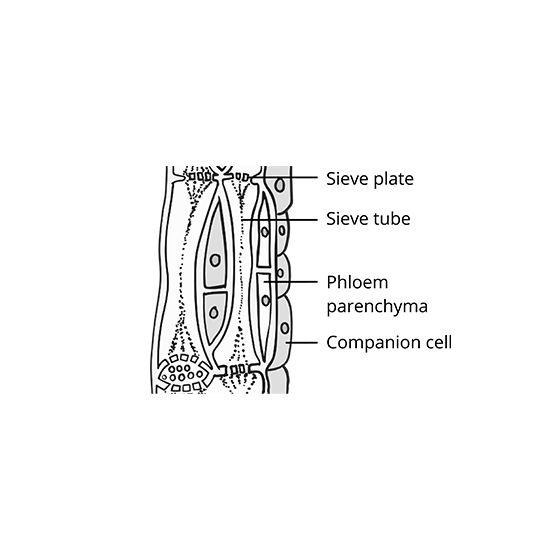
40. Write true (T) or false (F)
(a) Epithelial tissue is protective tissue in the animal body.
(b) The lining of blood vessels, lung alveoli, and kidney tubules are all made up of epithelial tissue.
(c) Epithelial cells have a lot of intercellular spaces.
(d) Epithelial layer is a permeable layer.
(e) Epithelial layer does not allow the regulation of materials between the body and the external environment.
Ans: (a)—T, (b)—T, (c)—F, (d) —T, (e)—F
41. Differentiate between voluntary and involuntary muscles. Give one example of each type.
Ans: The difference between voluntary and involuntary muscles.
Voluntary Muscles | Involuntary Muscles |
Voluntary muscles are skeletal muscles that function as per one's own will | Involuntary muscles, on the other hand, do not function as per one’s own will |
Contract and relax under conscious control | Are not under conscious control |
They have multinucleated cells. | They have uninucleated cells |
Example: Skeletal muscle, Limb muscle | Example: Smooth muscle, Cardiac muscle |
42. Differentiate the following activities on the basis of voluntary (V) or involuntary (IV) muscles.
(a) Jumping of frog
(b) Pumping of the heart
(c) Writing with hand
(d) Movement of chocolate in your intestine
Ans: (a)—V, (b)—IV, (c)—V, (d) —IV
43. Fill in the blanks
(a) Lining of blood vessels is made up of __________.
Ans: squamous epithelium
(b) Lining of the small intestine is made up of __________.
Ans: columnar epithelium
(c) Lining of kidney tubules is made up of __________.
Ans: cuboidal epithelium
(d) Epithelial cells with cilia are found in __________ of our body.
Ans: respiratory tract
44. Water hyacinth floats on the water surface. Explain.
Ans: Water hyacinth can float on water due to the presence of a special type of parenchymatous tissue called aerenchyma. This tissue has large air-filled spaces that provide buoyancy to the water hyacinth plant and therefore, the plant can easily float on the water surface.
45. Which structure protects the plant body against the invasion of parasites?
Ans: Epidermis has thick cuticle and dermal tissue to prevent the invasion of parasites and other harmful agents.
46. Fill in the blanks
(a) Cork cells possess __________ on their walls that makes them impervious to gases and water.
Ans: suberin
(b) __________ have tubular cells with perforated walls and are living in nature.
Ans: sieve tubes
(c) Bone possesses a hard matrix composed of __________ and __________.
Ans: calcium and phosphorus
47. Why is the epidermis important for plants?
Ans: Epidermis is important for plants because :
(i) it protects organs from the external environment.
(ii) protective covering against mechanical injury.
(iii) reduces water loss.
(iv) increases water absorption with the help of root hairs arising from the epidermis.
48. Fill in the blanks
(a) __________ are forms of complex tissue.
Ans: Xylem and phloem
(b) __________ have guard cells.
Ans: Stomata
(c) Cells of cork contain a chemical called __________.
Ans: Suberin
(d) Husk of coconut is made of __________ tissue.
Ans: Sclerenchyma
(e) __________ gives flexibility in plants.
Ans: Collenchyma
(f) __________ and __________ are both conducting tissues.
Ans: Xylem; phloem
(g) Xylem transports __________ and __________ from soil.
Ans: Water; minerals
(h) Phloem transport __________ from __________ to other parts of the plant.
Ans: food; leaves
Long Answer Questions
49. Differentiate between sclerenchyma and parenchyma tissues. Draw a well-labeled diagram.
Ans: The difference between parenchyma and sclerenchyma tissues:
Parenchyma | Sclerenchyma |
(1) Parenchyma tissues consist of living cells. | (1) Sclerenchyma is composed of dead cells. |
(2) Cell walls are thin and unspecialized | (2) Cell walls are uniformly thick and lignified |
(3) Parenchymatous cells carry out the process of photosynthesis, serve as a packing tissue, and as a food storage tissue. | (3) Sclerenchymatous cells provide strength and rigidity to the plant body. |
(4) Cells have extensive central vacuole and prominent nuclei. | (4) Cells lack nucleus and cytoplasm |
(5) Present in the root cortex, mesophyll of leaves, etc. | (5) Present in the root, leaf veins, seed coverings, etc. |
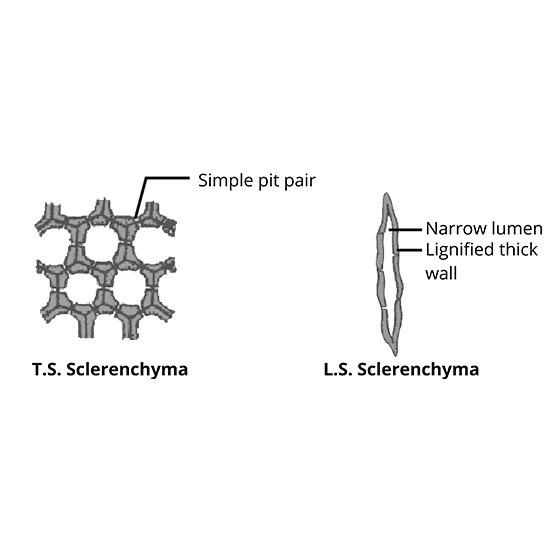
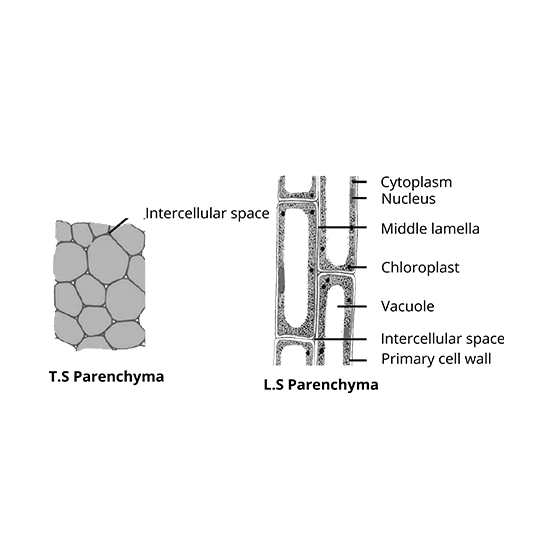
Various types of simple tissues: (a) Parenchyma (b) Collenchyma (c) Sclerenchyma transverse section (d) longitudinal section.
50. Describe the structure and function of different types of epithelial tissues. Draw diagrams of each type of epithelial tissue.
Ans: The human body consists of four types of tissue: epithelial, connective, muscular and nervous. Epithelial tissues are thin and cover all the exposed surfaces of our body, and keep different body systems separate. Epithelial tissues form the skin, the inner lining of the mouth, digestive tract, the lining of blood vessels, lung alveoli and kidney tubules, the lining of hollow parts of every organ such as heart, lungs, eyes, ears, the ventricular system of the brain, central canals of the spinal cord are all made of epithelial tissue.
Epithelial tissue cells are closely bound to one another with only a small amount of cementing material between them and almost no intercellular spaces.
They perform several functions such as protection from invasion of various pathogens, radiation damage, abrasion, excretion, filtration, diffusion etc. The permeability of the cells of various epithelia plays a part in regulating the exchange of materials between the body and the external environment and also between different parts of the body.
Different types of epithelial tissues are as follows:
(1) Simple squamous epithelium
(2) Stratified squamous epithelium
(3) Columnar epithelium, and
(4) Cuboidal epithelium.
(1) Simple squamous epithelium
These are simple, thin, single-layered, delicate and flat types of cells. Simple squamous epithelial cells are selectively permeable, form lining blood vessels, alveoli and lungs i.e. where transportation of substances takes place. Simple squamous epithelial cells also form the lining of the oesophagus, the skin and the mouth.
(2) Stratified squamous epithelium
These are multilayered, cells from multiple layers. Skin is made up of these issues. Stratified squamous cells are compactly placed in order to avoid wear and tear of the skin cells.
(3) Columnar epithelium
These cells are longitudinal, pillar-like and have outstretched nuclei. These cells are found where absorption and secretion occur, such as in the intestine’s inner lining.
Ciliated Columnar epithelium: Hair-like projections are found on the external surface of the epithelial cells, these projections are called cilia. These cilia are capable of movement and their movement pushes the substance forward. The ciliated columnar epithelium is found on the lining of the oviduct, lining of the trachea, kidney, etc.
(4) Cuboidal epithelium
These cells are cuboidal (cube-like) in shape. Cuboidal epithelial cells provide mechanical support and form the lining of kidney tubules. These cells also form the lining of salivary glands.
Glandular Epithelium: Epithelial cells often evolve into gland cells. The glandular epithelium is found in tear and sweat glands. They perform the function of secretion.
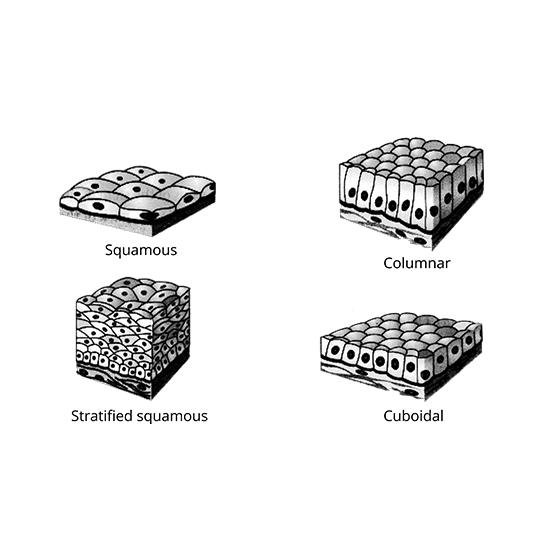
51. Draw well-labelled diagrams of various types of muscles found in the human body.
Ans: (a) Striated muscle
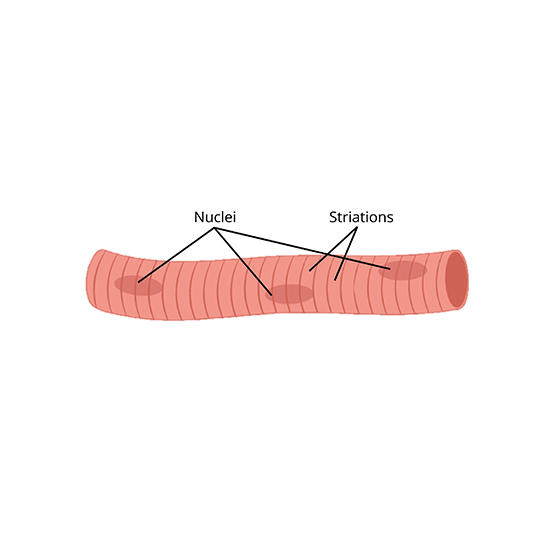
(b) Smooth muscles
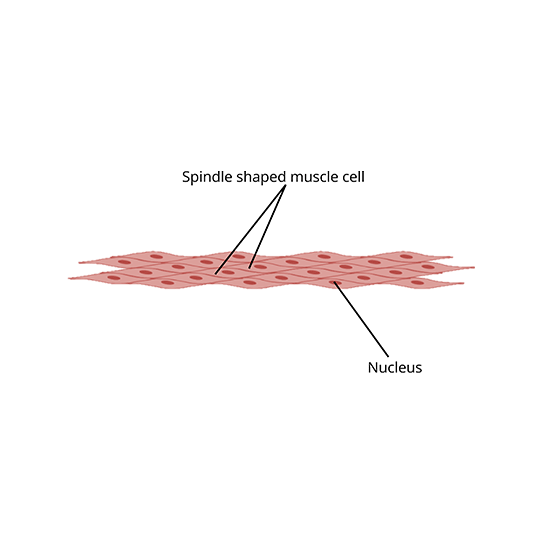
(c) Cardiac muscles
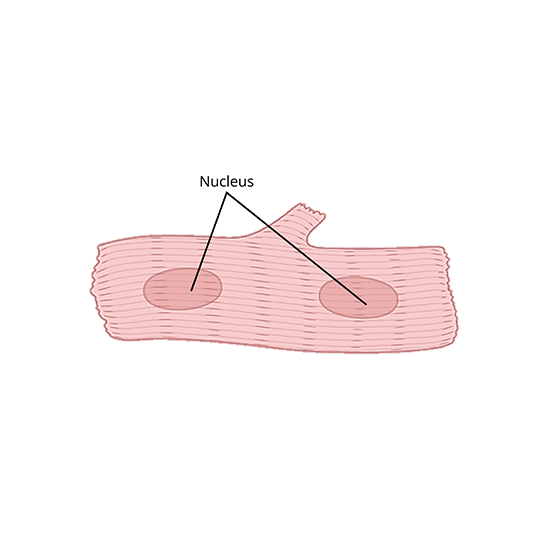
52. Give reasons for
(a) Meristematic cells have a prominent nucleus and dense cytoplasm but they lack vacuole.
Ans: Meristematic cells have prominent nuclei and dense cytoplasm, they continue diving throughout their lifetime. Meristematic cells divide constantly and give rise to new cells hence they do not need to maintain a definite shape and store food or accumulate waste material. Therefore, vacuoles are absent in meristematic cells.
(b) Intercellular spaces are absent in sclerenchymatous tissues.
Ans: Intercellular spaces are absent in sclerenchymatous tissues because they have lignified cell walls. They are organized closely and are meant to provide strength and protection to the plant parts.
(c) We get a crunchy and granular feeling when we chew pear fruit.
Ans: Sclerenchymatous tissues are present in pear fruit. They are small, thickened and hard due to the presence of lignin. As a result, we get a crunchy and granular feeling when we chew pear fruit.
(d) Branches of a tree move and bend freely in high wind velocity.
Ans: Branches of a tree bend freely in high wind velocity due to the presence of collenchyma. Collenchyma is present at the junction of branches. It provides rigidity with flexibility.
(e) It is difficult to pull out the husk of a coconut tree.
Ans: The husk of a coconut tree is made up of sclerenchymatous tissues. Sclerenchyma cells are lignified and are packed densely for the protection of the plant. Hence, it is difficult to pull out the husk of a coconut tree.
53. List the characteristics of cork. How are they formed? Mention their role.
Ans: a) Characteristics of cork are as follows:
It is an outer protective tissue layer of the oldest stem.
Cork cells are dead at maturity.
Cells are compactly arranged and cells do not have intercellular spaces.
A chemical substance called Suberin is present in their cell walls.
Cells are thick and made up of several layers
b) At maturity, secondary meristem replaces the epidermis of the stem. Cells that are cut on the outer side by this meristem are then called cork.
c) The Main function is to provide protection to older stem/twigs/branches and prevent water loss. The tick material is impervious to water and works as an insulator.
54. Why are xylem and phloem called complex tissues? How are they different from one another?
Ans: A tissue made up of more than one or more types of cells and they work together as a unit is known as Complex tissue. Both xylem and phloem are made up of more than one type of cell and that's why they are known as complex tissues.
Xylem | Phloem |
Transport of water and minerals by xylem is unidirectional. | Transport of food material by phloem is bidirectional. |
Xylem elements are tracheids, vessels, xylem parenchyma, and xylem fibers. | Phloem elements are sieve tubes, companion cells, phloem parenchyma, and phloem fibers. |
It gives mechanical strength to the plant. | It does not provide mechanical strength to the plant. |
55. (a) Differentiate between meristematic and permanent tissues in plants.
Ans:
Meristematic Tissue | Permanent Tissue |
Cells of this tissue are living small, Spherical, and undifferentiated. | Cells of this tissue may be living or dead, various shapes, large and differentiated. |
Cells are capable of division throughout their lifetime | Cells take up a specific function and lose their ability to divide |
Intercellular spaces are absent | Intercellular spaces are absent |
Meristematic tissues are found in specific regions of the plant i.e. Apical, Lateral, Intercalary | Permanent tissues are located beneath the epidermis and spread throughout the plant body |
(b) Define the process of differentiation.
Ans: Differentiation is a process in which the cell loses its ability to divide and takes up a permanent shape, size and function. Young cells evolve to become specialized cells, develop into tissues and organs with the help of differentiation.
(c) Name any two simple and two complex permanent tissues in plants.
Ans: (i)The two simple tissues in plants are: Parenchyma/collenchyma/sclerenchyma.
(ii) The two complex tissues in plants are xylem/phloem.
Overview of Class 9 Science Chapter 6 - Tissues
The Chapter on Tissues begins by defining what tissues essentially are. They are composed of dead cells and help in providing some sort of mechanical strength. Animal and plant tissues have been explained. Students then learn about Permanent tissue and Meristematic tissue. After the study of Cells, students have to deal with the chapter on Tissues. The distinction between animal and plant tissues will enable the students to grasp the concepts more clearly. The experts have strategically condensed the chapter on Tissues in the form of notes as well as solved exercise questions.
Learning about these issues in depth will help you in understanding larger related concepts when they feature in the higher classes.
FAQs on NCERT Exemplar for Class 9 Science Chapter 6 - Tissues (Book Solutions)
1. What essentially are tissues?
A group of cells that have a similar shape and function and act together to perform a specific function, are called Tissues. All our body organs are composed of tissues. The explanations for these are provided in NCERT Exemplar for Class 9 Science Chapter 6 – Tissues which has been made in consultation with the eminent Science teachers. The questions and answers provided are apt for studying before examinations and can be found on Vedantu free of cost.
2. Where can I find questions on Class 9 Science Chapter 6- Tissues?
You can find related questions in NCERT Exemplar for Class 9 Science Chapter 6 – Tissues. The book is available on Vedantu.
The book has solved answers and challenging questions in the form of multiple-choice questions, short answers, long answers. The questions asked are many and so, the entire chapter gets covered as a result. It is a great book for those looking to solve questions before sitting for tests. It also helps one make revision notes to decipher the topics in a better manner.
3. Do experts create the Solutions for NCERT Exemplar for Class 9 Science Tissues for Vedantu?
Indeed. Vedantu only has the most qualified teachers writing for its platform. Vedantu does not believe in degrading its standard by assigning the task of creating content for its portal to just anyone. Proper screening of the contributors is held before their being hired by Vedantu. Thus, the content available on its e-learning platform is remarkably good and very relevant for the students who use them for their academic needs. One must rest assured of that and have faith in the portal.
4. Where can I get a summarized version of NCERT Class 9 Science Chapter 6- Tissues?
You can find a condensed version of this chapter on Vedantu. Go to NCERT Exemplar for Class 9 Science Chapter 6 – Tissues and study from the notes provided. It has a summarized version of the chapter along with a section on exercise questions and their solutions for you to revise properly. Scanning these questions before examinations take place will help instil confidence in you and also ensure that you perform brilliantly. These questions are also suitable for those prepping up for competitive examinations.
5. What is Collenchyma?
Elongated living cells with tiny intercellular spaces are named Collenchymas. Their cell walls are made up of cellulose and pectins. They appear in the peripheries of cells and leaves to lend mechanical support as well as flexibility to the plants.
Such explanations are readily available in NCERT Exemplar for Class 9 Science Chapter 6 – Tissues. The book of solved questions and answers is truly magical for students who need practice. All students must scan the notes available as well as the solved exercises to secure good grades. The book has been made by NCERT guidelines.































